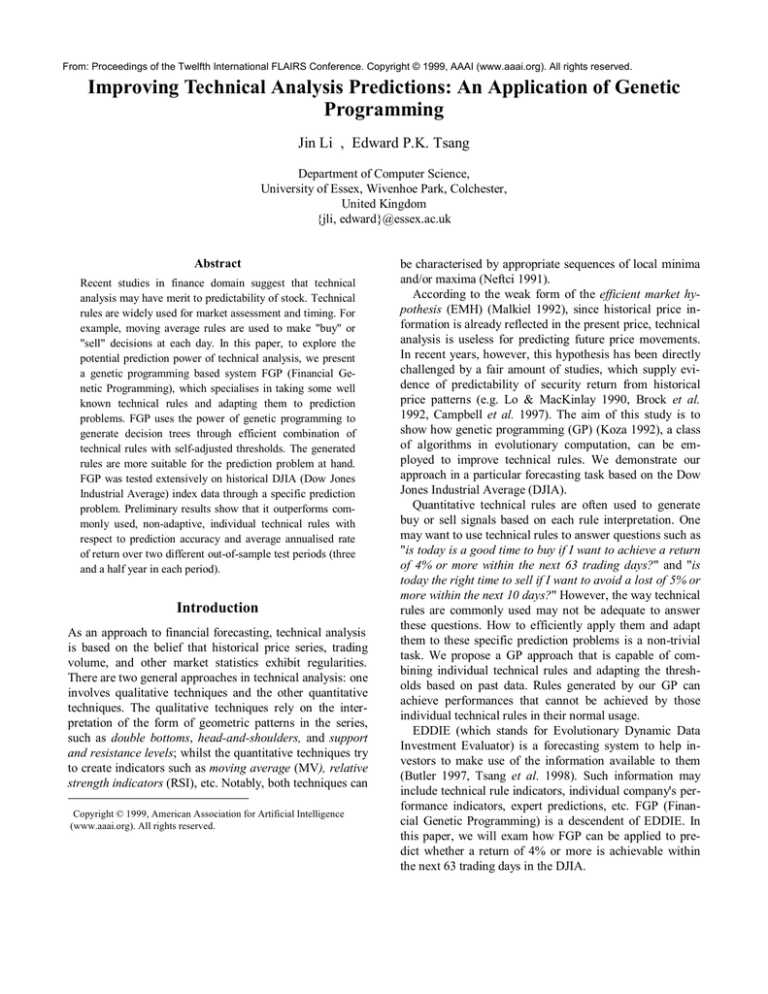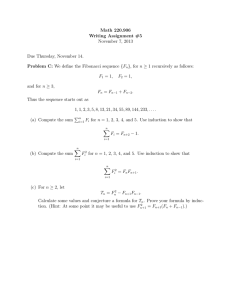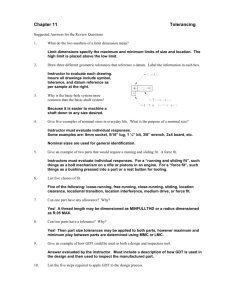
From: Proceedings of the Twelfth International FLAIRS Conference. Copyright © 1999, AAAI (www.aaai.org). All rights reserved.
Improving Technical Analysis Predictions: An Application of Genetic
Programming
Jin Li , Edward P.K. Tsang
Department of Computer Science,
University of Essex, Wivenhoe Park, Colchester,
United Kingdom
{jli, edward}@essex.ac.uk
Abstract
Recent studies in finance domain suggest that technical
analysis may have merit to predictability of stock. Technical
rules are widely used for market assessment and timing. For
example, moving average rules are used to make "buy" or
"sell" decisions at each day. In this paper, to explore the
potential prediction power of technical analysis, we present
a genetic programming based system FGP (Financial Genetic Programming), which specialises in taking some well
known technical rules and adapting them to prediction
problems. FGP uses the power of genetic programming to
generate decision trees through efficient combination of
technical rules with self-adjusted thresholds. The generated
rules are more suitable for the prediction problem at hand.
FGP was tested extensively on historical DJIA (Dow Jones
Industrial Average) index data through a specific prediction
problem. Preliminary results show that it outperforms commonly used, non-adaptive, individual technical rules with
respect to prediction accuracy and average annualised rate
of return over two different out-of-sample test periods (three
and a half year in each period).
Introduction
As an approach to financial forecasting, technical analysis
is based on the belief that historical price series, trading
volume, and other market statistics exhibit regularities.
There are two general approaches in technical analysis: one
involves qualitative techniques and the other quantitative
techniques. The qualitative techniques rely on the interpretation of the form of geometric patterns in the series,
such as double bottoms, head-and-shoulders, and support
and resistance levels; whilst the quantitative techniques try
to create indicators such as moving average (MV), relative
strength indicators (RSI), etc. Notably, both techniques can
Copyright © 1999, American Association for Artificial Intelligence
(www.aaai.org). All rights reserved.
be characterised by appropriate sequences of local minima
and/or maxima (Neftci 1991).
According to the weak form of the efficient market hypothesis (EMH) (Malkiel 1992), since historical price information is already reflected in the present price, technical
analysis is useless for predicting future price movements.
In recent years, however, this hypothesis has been directly
challenged by a fair amount of studies, which supply evidence of predictability of security return from historical
price patterns (e.g. Lo & MacKinlay 1990, Brock et al.
1992, Campbell et al. 1997). The aim of this study is to
show how genetic programming (GP) (Koza 1992), a class
of algorithms in evolutionary computation, can be employed to improve technical rules. We demonstrate our
approach in a particular forecasting task based on the Dow
Jones Industrial Average (DJIA).
Quantitative technical rules are often used to generate
buy or sell signals based on each rule interpretation. One
may want to use technical rules to answer questions such as
"is today is a good time to buy if I want to achieve a return
of 4% or more within the next 63 trading days?" and "is
today the right time to sell if I want to avoid a lost of 5% or
more within the next 10 days?" However, the way technical
rules are commonly used may not be adequate to answer
these questions. How to efficiently apply them and adapt
them to these specific prediction problems is a non-trivial
task. We propose a GP approach that is capable of combining individual technical rules and adapting the thresholds based on past data. Rules generated by our GP can
achieve performances that cannot be achieved by those
individual technical rules in their normal usage.
EDDIE (which stands for Evolutionary Dynamic Data
Investment Evaluator) is a forecasting system to help investors to make use of the information available to them
(Butler 1997, Tsang et al. 1998). Such information may
include technical rule indicators, individual company's performance indicators, expert predictions, etc. FGP (Financial Genetic Programming) is a descendent of EDDIE. In
this paper, we will exam how FGP can be applied to predict whether a return of 4% or more is achievable within
the next 63 trading days in the DJIA.
From: Proceedings of the Twelfth International FLAIRS Conference. Copyright © 1999, AAAI (www.aaai.org). All rights reserved.
Is X’s price-earning ratio 10% or more below
than the average in DJIA 30 shares?
yes
no
Has X’s price risen by 5% or more than
the minimum price of last 63 days?
no
yes
Buy
Is X’s 50 days moving average higher
than its price during the last three days?
yes
Has X’s price fallen by 10%
or more since yesterday?
yes
Sell
Sell
no
No action
no
No action
Figure 1. A (simplistic) GDT concerning the actions to take with Share X
Background of FGP
Genetic programming is a promising variant of genetic
algorithms (Holland 1975; Goldberg 1989) that uses tree
representations instead of strings. In evolutionary computation, a population (set) of candidate solutions is maintained. For example, a candidate solution could be a decision tree for forecasting. A fitness function is needed to
evaluate the quality of each candidate solution with regard
to the task to be performed (e.g. how good is a rule for
forecasting in our application?). Candidate solutions are
selected randomly, biased by their fitness, for involvement
in generating members of the next generation. General
mechanisms (referred to as genetic operators, e.g. reproduction, crossover, mutation) are used to combine or
change the selected candidate solutions to generate offspring, which will form the population in the next generation.
Evolutionary computation has been applied to a broad
range of problems with some success from traditional optimisation in engineering and operational research to nontraditional areas such as data mining, composition of music
(Angeline & Kinnear 1996; Koza 1996) and financial prediction (e.g., Bauer 1994, Mahfoud & Mani 1996, Chen &
Yeh 1996, Oussaidene et al. 1997).
In FGP, a candidate solution is represented by a genetic
decision tree (GDT). The basic elements of GDTs are rules
and forecast values, which correspond to the functions and
terminals in GP. Figure 1 shows an example of a simple
GDT. In GP terms, the questions in the example GDT are
functions, and the proposed actions are terminals, which
may also be forecast values.
A GDT can be seen as a set of rules. For example, one of
the rules expressed in the GDT in Figure 1 is:
IF X's price earning ratio is 10% or more below
the average in DJIA 30 shares AND X's price has
risen by 5% or more than the minimum price of
last 63 days, THEN Buy X.
For FGP to work, one must be able to evaluate each
GDT. In this paper, we use prediction accuracy (the percentage of correct predictions) as fitness function. Our FGP
maintains a set of GDTs called a population and works in
iterations. In each iteration, FGP creates a new generation
of population using standard genetic crossover, mutation
and reproduction operators. FGP uses tournament as its
selection strategies.
There are many variations in the way the initial population is generated, the way that the population is updated,
the way that crossover and mutation is done, etc. (e.g. see
Angeline & Kinnear 1996, Koza et. al. 1996). These will
not be elaborated here.
FGP for prediction in DJIA index
We took the Dow Jones Industrial Average (DJIA) index
data from 7 April 1969 to 11 October 1976 (1,900 trading
days) as training data (or in-sample data) to generate
GDTs, and tested them on the data (or out-of-sample data)
from 12 October 1976 to 5 May 1980 (900 trading days),
which we shall refer to as "test data I". We used a population size of 1,800, crossover rate of 90%, reproduction rate
of 10% and a mutation rate of 1%. The termination condition was 2 hours on a Pentium PC (200 MHz) or 30 generations, whichever reached first. 20 runs were completed
in our experiments. Each run generated one GDT. The generated rules were used to predict whether the following
goal is achievable at any given day:
Goal G: the index will rise by 4 % or more within the
next 63 trading days (3 months).
Accordingly, each trading day is classified into "buy"
category if G holds or "not-buy" category if G does not
hold. The numbers of trading days that belong in each
category are roughly same over both the whole training and
test period.
We used {If-then-else, And, Or, Not, <, >} as functions.
Terminals were conclusions, numbers or indicators. Conclusions could be either Positive (meaning that G is predicted to be achievable) or Negative. Six technical indicators were derived from rules in the finance literature, such
as (Brock et. al. 1992; Fama & Blume 1966; Sweeney
1988). They are listed as follows:
(1) MV_12 = Today's price − the average price of the
previous 12 trading days
(2) MV_50 = Today's price − the average price of the
previous 50 trading days
(3) Filter_5 = Today's price − the minimum price of the
previous 5 trading days
(4) Filter_63 = Today's price − the minimum price of the
previous 63 trading days
(5) TRB_5 = Today's price − the maximum price of the
previous 5 trading days (based on the Trading
Range Breakout rule [Brock et. al. 1992]).
(6) TRB_50 = Today's price − the maximum price of the
previous 50 trading days
Each of the above six indicators is related to some technical analysis rules in the literature. We compared the corresponding six individual technical rules with the GDTs
generated by FGP in terms of two criteria: prediction accuracy and average annualised rate of return (AARR). A
recommendation is correct if the goal can be achieved
when the recommendation is "buy", or the goal cannot be
achieved when the recommendation suggests "do not buy".
The prediction accuracy of a program or a rule measures
the proportion of correct recommendations made by that
program or rule. Prediction accuracy is used for evaluating
the program's performance because this is what we train
the program with. Given any prediction, no matter how
accurate they are, the actual return to an investor depends
on the investment behaviour, which vary from investor to
investor. For reference, we use a simple hypothetical trading behaviour later.
First, we shall explain what our program is compared
against. In (Tsang et al 1998), FGP was compared with
random decisions with a uniformly distributed 50% chance.
In this paper, we show that FGP can do better than simple
rules that use the input indicators, as it considers the interaction between the indicators. We compare FGP with six
individual technical rules that use the above six indicators
to generate "buy" or "not-buy" signals in the following
ways. The moving average rules (1) and (2) generate "buy"
signals if today's price is greater than the average price of
the preceding n days (where n = 12 and 50 respectively).
The filter rules (3) and (4) generate "buy" signals if today's
price has risen by 1% or more over the minimum price of
the previous n days (n = 5 and 63 respectively). Here 1% is
a threshold that an investor has to choose. The trading
range breakout rules (5) and (6) generate "buy" signals if
today's price is greater than the maximum price over the
previous n days (n = 5 and 50 respectively). AARR was
calculated based on the following trading behaviour:
Hypothetical trading behaviour: we assume that
whenever a buy signal is indicated by a rule, one
unit of money was invested in a portfolio reflecting the DJIA index. If the DJIA index does
rise by 4% or more at day t within the next 63
days, then we sell the portfolio at the index price
of day t. If not, we sell the portfolio on the 63rd
day, regardless of the price. We annualise the
return of each unit invested; for example, if 4%
is achieved at the 21st trading day (i.e. one
month), then the annualised return is (4 × 12 =)
48%. We refer to the mean of these annualised
returns as AARR.
For simplicity, we ignored transaction costs and bid-ask
spread. Rules generated by FGP were tested against the
above six individual technical rules in the test data. Results
are shown in the column of "On test data I" in table 1.
Among the six technical rules, Filter_5 performed best in
this set of data. It achieved an accuracy of 52.67% and an
AARR of 23.03%. The 20 GDTs achieved an accuracy of
57.97% in average and an average AARR of 27.79%,
which is better than the Filter_5 rule. In fact, even the
poorest GDT achieved an accuracy of 53.00% (GDT 18)
and AARR of 23.57% (GDT 2), which are still better than
the Filter_5 rule. Our results show conclusively that FGP is
capable of generating good rules based on the same indicators used by the technical rules.
To test the robustness of the 20 GDTs across different periods, we applied them to a more recent period, from 10
April 1981 to 29 October 1984 (900 trading days), which
we shall refer to as "test data II". The test results are illustrated in the column of "On test data II" in table 1.
20 GDTs
GDT 1
GDT 2
GDT 3
GDT 4
GDT 5
GDT 6
GDT 7
GDT 8
GDT 9
GDT 10
GDT 11
GDT 12
GDT 13
GDT 14
GDT 15
GDT 16
GDT 17
GDT 18
GDT 19
GDT 20
Highest
Lowest
Mean
Standard Deviation
6 Technical Rules
MV_12
MV_50
TRB_5
TRB_50
Filter_5 (1%)
Filter_63 (1%)
On test data Ι
Accuracy
AARR
On test data ΙΙ
Accuracy
AARR
60.22%
53.67%
62.00%
58.00%
60.22%
55.11%
61.33%
57.89%
60.67%
55.78%
62.44%
56.78%
56.11%
60.56%
54.78%
56.00%
60.56%
53.00%
60.67%
53.67%
27.56%
23.57%
31.71%
36.55%
28.23%
29.76%
30.52%
27.16%
28.75%
26.34%
25.93%
25.88%
26.85%
29.66%
25.43%
25.82%
29.18%
23.82%
28.80%
24.18%
53.89%
53.11%
57.89%
52.33%
63.33%
55.00%
58.00%
54.00%
61.56%
59.11%
55.22%
56.44%
56.44%
54.89%
55.11%
58.11%
58.00%
58.67%
62.89%
57.22%
55.25%
54.74%
57.80%
61.81%
58.53%
67.00%
56.23%
54.54%
57.69%
59.83%
57.37%
53.19%
59.91%
53.12%
58.05%
59.10%
58.82%
56.61%
58.56%
56.38%
62.44%
53.00%
57.97%
3.07%
31.71%
23.57%
27.79%
3.06%
63.33%
52.33%
57.06%
3.06%
67.00%
53.12%
57.73%
3.15%
(the best result in each column is highlighted)
51.44%
42.56%
49.44%
47.44%
52.67%
50.56%
20.68%
16.94%
18.18%
-5.34%
23.03%
22.77%
44.89%
41.89%
47.44%
48.67%
49.44%
48.89%
36.66%
46.85%
55.33%
67.00%
54.53%
48.76%
Table 1. Performance comparisons between 20 FGP-generated GDTs and six technical rules
on test data I (12/10/1976-05/05/1980-900 trading days) and
on test data II (10/04/1981-29/10/1984-900 trading days)
of the Dow Jones Industrial Average (DJIA) Index
The GDTs achieved an average accuracy of 57.06%,
which out-performs all the six technical rules. As in test
data set I, even the poorest GDT performed better than all
the technical rules on prediction accuracy. The GDTs
achieved an average AARR of 57.73%, which is also better
than AARRs produced by the technical rules except the
TRB_50 rule1. Test results on data set II further demonstrate the quality of the GDTs generated by FGP.
Two issues are worth pointing out. First, although the
number of runs is relatively small, the results are significant because the amount of data tested is large and the re1
Note that the TRB_50 rule is not particularly reliable. It achieved the
lowest AARR in test data I (−5.34%) but the highest AARR in test data II
(67.00%). The erratic performance of the TRB_50 rule is partly due to the
fact that it generates very few buy signals.
sults are consistent. It is encouraging to see that our GDTs
achieve nearly the same mean of accuracy (57.97%,
57.06%) with almost the same standard deviation (3.07%,
3.06%) over two test periods. Second, our calculation of
AARR assumes that funds are always available whenever a
positive position is predicted, and such funds have no cost
when idle. Exactly how one can make use of the predictions by the GDTs is beyond this paper.
Conclusion and further work
It is not our role to defend technical analysis here, although
our results show that there is some predictability in the
DJIA index based on historical data alone. Our main objective is to illustrate that by taking indicators used in technical rules as input, FGP, a genetic programming based
system, can generate decision trees that perform better than
those technical rules. For the specific task tested, FGP reliably generated accurate GDTs that perform better than the
individual technical rules. This involves combining indicators in individual technical rules and finding thresholds
in different parts of the decision trees.
The application presented here is not complete since important issues such as transaction costs and capital adequacy were ignored. In the future, we plan to consider
these factors. We intend to bring in constraint satisfaction
techniques, which have been demonstrated to be useful in
genetic algorithms (Lau & Tsang 1997; Tsang 1993).
Acknowledgements
This work is partly supported by the Research Promotion
Fund, 1997 (DDP540), University of Essex. Jin Li is supported by an Overseas Research Students Award (ORS)
and a University of Essex Studentship. The DJIA index
data was generously provided by Professor Blake LeBaron
at University of Wisconsin - Madison. The anonymous
referees provided valuable comments.
References
Angeline, P. & Kinnear, K.E., eds. (1996). Advances in
genetic programming II, MIT Press.
Bauer, R. J. Jr. (1994). Genetic Algorithms and Investment
Strategies. New York, John Wiley & Sons, Inc.
Brock, W.; Lakonishok, J. and LeBaron, B. (1992). Simple
technical trading rules and the stochastic properties of
stock returns. Journal of Finance, 47, 1731-1764.
Butler, J. M. (1997). Eddie beats the market, data mining
and decision support through genetic programming.
Developments, Reuters Limited, Vol1.
Campbell, J. Y.; Lo, A. W.; & MacKinlay, A. C. (1997).
The econometrics of financial markets. Princeton, N.J.:
Princeton University Press.
Chen, S-H & Yeh, C-H. (1996). Toward a computable approach to the efficient market hypothesis: An application of genetic programming, Journal of Economic Dynamics and Control, 21, 1043-1063.
Fama, E. F. & Blume, M. E. (1966). filter rules and stockmarket trading. Journal of Business 39(1), 226-241.
Goldberg, D.E. (1989). Genetic Algorithms in Search, Optimization and Machine Learning. Addison-Wesley.
Holland, J. H. (1975). Adaptation in natural and artificial
system. University of Michigan Press.
Koza, J. R. (1992). Genetic Programming: on the programming of computers by means of natural selection.
MIT Press.
Koza, J.; Goldberg, D.; Fogel, D. and Riolo, R. eds. (1996).
Procedings of the First Annual Confrence on Genetic
programming. MIT Press.
Lau, T. L. & Tsang, E.P.K. (1997). Solving the processor
configuration problem with a mutation-based genetic
algorithm. International Journal on Artificial Intelligence Tools (IJAIT), World Scientific, Vol.6, No.4,
567-585.
Lo, A.W. & MacKinlay, A. C. (1990). When are contrarian
profits due to stock market overreaction? Review of Financial Studies 3, 175-206.
Mahfoud, S. & Mani, G. (1996). Financial Forecasting
Using Genetic Algorithms. Journal of Applied Artificial
Intelligence Vol.10, Num 6, 543-565.
Malkiel, B. (1992). Efficient market Hypothesis. In Newman, P.; Milgate, M. and Eatwell, J.(eds.), New Palgrave Dictionary of Money and Finance, Macmillan,
London, pp739.
Neftci, S. N. (1991). Naïve trading rules in financial markets and Wiener-Kolmogorov prediction theory: A
study of 'technical analysis'. Journal of Business, 64,
549-571.
Oussaidene, M.; Chopard, B.; Pictet, O. and Tomassini, M.
(1997). Practical aspects and experiences - Parallel genetic programming and its application to trading model
induction. Journal of Parallel Computing Vol. 23, No.
8, 1183-1198.
Sweeney, R. J. (1988). Some new filter rule tests: Methods
and results. Journal of Financial and Quantitative
Analysis, 23, 285-300.
Tsang, E. P. K.; Butler, J. M. & Li, J. (1998). EDDIE beats
the bookies. International Journal of Software, Practice
& Experience, Wiley, Vol.28 (10), 1033-1043.
Tsang, E.P.K. (1993). Foundations of constraint satisfaction. Academic Press, London.






